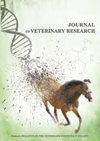绵羊扭曲血蜱的多药耐药——能被克服吗?
IF 1.3
3区 农林科学
Q2 VETERINARY SCIENCES
引用次数: 0
摘要
胃肠道线虫对动物健康构成威胁,并通过对农场管理产生负面影响来影响农民。材料和方法本研究是在一个羊场进行的,该羊场疑似出现了驱虫剂功效下降的情况。通过体内粪卵计数减少、体外卵孵化(EHT)和幼虫发育(LDT)试验来确定效果。在第一阶段,60只羊被平均分成6组。组1给予阿苯达唑推荐剂量,组2禁食24 h后给予阿苯达唑推荐剂量,组3每隔6 h给予两半剂量,组4给予双倍剂量的阿苯达唑,组5给予伊维菌素推荐剂量。第6组为对照组。第二阶段实验分为两组:一组用左旋咪唑(LEV)治疗,另一组为对照组。收集了所有绵羊的粪便样本。结果单剂量、双剂量或分剂量ALB组均未观察到卵量减少,但禁食组有13.7-16.9%的卵量减少。IVM组有效率为31.50% ~ 39.97%。在体外EHT中足以阻止50%的卵孵化的平均浓度和在LDT中抑制50%的幼虫发育到L3期的平均浓度超过了苯并咪唑和IVM的既定阈值。处理后鉴定出的品种只有弯血蜱。LDT不表明存在对LEV的抗性。所有经LEV处理的动物在处理后10 d卵均为阴性。结论扭曲血蜱对ALB和IVM均有耐药性。改善苯并咪唑疗效的其他方法不能充分提高疗效,但LEV是一种有效的驱虫剂治疗方法。本文章由计算机程序翻译,如有差异,请以英文原文为准。
Multidrug resistance in Haemonchus contortus in sheep - can it be overcome?
Abstract Introduction Gastrointestinal nematodes pose a threat to animal health and affect farmers by negatively impacting farm management. Material and Methods The study was conducted on a sheep farm with suspected reductions in the efficacies of anthelmintics. Efficacy was determined using in vivo faecal egg count reduction, in vitro egg hatch (EHT) and larval development (LDT) tests. In the first phase, 60 sheep were equally split into six groups. Group 1 received the recommended dose of albendazole (ALB), group 2 received the same after fasting for 24 h, group 3 received the dose divided into two halves at 6 h intervals, group 4 received a double dose of ALB, and group 5 received the recommended dose of ivermectin (IVM). Group 6 served as a control. The second phase of the experiment had two groups: one treated with levamisole (LEV) and a control group. Faecal samples were collected from all sheep. Results No reduction of egg output was observed in the groups treated with single, double, or divided doses of ALB, but one of 13.7–16.9% was noted in the fasting group. Efficacy in the IVM group ranged from 31.50 to 39.97%. The mean concentrations sufficient to prevent 50% of the eggs from hatching in the in vitro EHT and the mean concentrations in which the development of larvae to the L3 stage was inhibited by 50% in the LDT exceeded established thresholds for benzimidazoles and IVM. Haemonchus contortus was the only species identified after treatment. The LDT did not indicate the presence of resistance to LEV. All animals treated with LEV were negative for eggs 10 d after treatment. Conclusion Resistance to ALB and IVM in Haemonchus contortus was confirmed. Alternative approaches to improve the efficacies of benzimidazole did not sufficiently increase the efficacy, but LEV was an efficient anthelmintic treatment.
求助全文
通过发布文献求助,成功后即可免费获取论文全文。
去求助
来源期刊

Journal of Veterinary Research
Veterinary-General Veterinary
CiteScore
0.90
自引率
5.60%
发文量
58
审稿时长
18 weeks
期刊介绍:
Journal of Veterinary Research (formerly Bulletin of the Veterinary Institute in Pulawy) is a quarterly that publishes original papers, review articles and short communications on bacteriology, virology, parasitology, immunology, molecular biology, pathology, toxicology, pharmacology, and biochemistry. The main emphasis is, however, on infectious diseases of animals, food safety and public health, and clinical sciences.
 求助内容:
求助内容: 应助结果提醒方式:
应助结果提醒方式:


